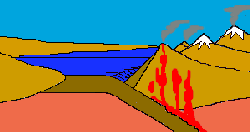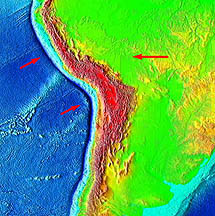|
Ocean/continent convergence
 When
an oceanic plate and a continental plate meet, the continental plate will
remain the up plate because it is the less dense of the two, and the oceanic
plate will be subducted. As in the previous case, the edges of the
plates will be deformed, and there will be a trench. Volcanos
again form on the up plate, this time on the edge of the continent. As
the oceanic plate plunges underneath the continental plate, shallow,
intermediate and deep focus earthquakes generated by the descending
plate rack the continent. The upper layers of the descending oceanic plate
will be scraped and welded onto the continent in an accretionary wedge.
Finally, the edge of the continent, being compressed by the action of the
oceanic plate, will be deformed by faults and folds forming marginal
mountain chains on the edge of the continent. When
an oceanic plate and a continental plate meet, the continental plate will
remain the up plate because it is the less dense of the two, and the oceanic
plate will be subducted. As in the previous case, the edges of the
plates will be deformed, and there will be a trench. Volcanos
again form on the up plate, this time on the edge of the continent. As
the oceanic plate plunges underneath the continental plate, shallow,
intermediate and deep focus earthquakes generated by the descending
plate rack the continent. The upper layers of the descending oceanic plate
will be scraped and welded onto the continent in an accretionary wedge.
Finally, the edge of the continent, being compressed by the action of the
oceanic plate, will be deformed by faults and folds forming marginal
mountain chains on the edge of the continent.

The Andes, a marginal mountain range in South America, are an excellent
example of such a mountain range. The trench is clearly visible as the
very dark blue line oceanward of the continent, on the margin of the Pacific
plate. |

